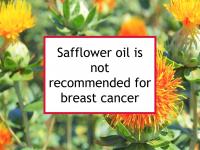Safflower (Carthamus tinctorius) is an annual plant with yellow flowers which is grown for its seeds, from which the oil is extracted. Safflower oil is a polyunsaturated oil consisting primarily of the omega-6 fatty acid linoleic acid. It also contains some campesterol, oleic acid and palmitic acid.
Safflower oil has been shown to promote inflammation. At 71% to 75%, safflower oil has the highest proportion of linoleic acid of all common cooking oils. Linoleic acid is converted into arachidonic acid in the body. Linoleic acid has been shown to enhance the invasion and peritoneal metastasis of gastric carcinoma cells.
Breast cancer-related effects of consuming safflower oil
Safflower oil and linoleic acid have been linked to increased breast cancer risk in human, animal and cell studies.
Human studies
Women with breast cancer have been found to have higher levels of omega-6 fats in their breast tissue than similar women without breast cancer. Several studies have found that lower dietary omega-6/omega-3 ratios are associated with reduced risk of breast cancer. Consuming safflower oil would tend to increase the ratio for most women because of its high omega-6 content.
One study reported that women with a specific genotype (ALOX5AP −4900 A > G polymorphism) who consumed a significant amount of linoleic acid in their diets had an increased risk of breast cancer. Another study found increased breast cancer risk among women cooking primarily with high linoleic acid vegetable oil compared to women using olive or canola oil.
Animal studies
While animal studies regarding safflower oil are uncommon, numerous studies have been performed with diets high in corn oil (another high-linoleic acid oil) or arachidonic acid in mice or rats bearing either carcinogen-induced tumors or transplanted mammary tumors. Such diets were found to stimulate the formation and growth of breast tumors in the animals.
One 2025 study reported that feeding animals bearing triple negative patient-derived xenograft tumors with a diet enriched with safflower oil promoted triple negative tumor growth.
Daughter mice of female mice fed a high linoleic acid diet have been observed to be more prone to develop mammary tumors.
Cell studies
Linoleic acid has been reported to promote migration, invasion and angiogenesis of triple negative (ER-/PR-/HER2-) breast cancer cells in several studies.
Insulin is a hormone well known to be involved in the metabolism of carbohydrates. However, insulin is also a growth factor that can stimulate cell proliferation and migration. High circulating insulin levels such as those typical of type 2 diabetes have been shown to increase the risk of breast cancer and its recurrence. Linoleic acid has been shown to amplify the deleterious responses to insulin in both ER+/PR+ and triple negative breast cancer cells.
Additional comments
Note that the breast cancer-linoleic acid connection is not straightforward since omega-6 fats are essential to health. The ratio of omega-6 to omega-3 fats (such as the docosahexaenoic acid (DHA) found in fatty fish) appears to be more important than the absolute amounts of these fatty acids in the diet.
Dietary sources of linoleic acid
Below are common cooking oils with high levels of linoleic acid as a percentage of total fat content:
| Cooking oil | Linoleic acid |
|---|---|
| Safflower oil | 71% to 75% |
| Sunflower oil | 53% to 66% |
| Corn oil | 55% to 59% |
| Soybean oil | 51% to 56% |
Better choices are olive oil (7% to 15% linoleic acid) or canola oil (19% to 26%).
Sources of information in this webpage
The information above, which is updated continually as new research becomes available, has been developed based solely on the results of academic studies. Clicking on any of the underlined terms will take you to its tag or webpage, which contain more extensive information.
Below are links to recent studies concerning this food and its components. Note that while we are continually searching for new evidence specifically concerning this food, there is not much interest in it among breast cancer researchers, so few studies focusing on safflower oil are available.
